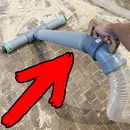Introduction: Rustic Coat Rack Using Shou-sugi-ban
Every corridor need a coat rack.For us, a random IKEA one did not fill the bill, so I decided to build my own custom designed reclaimed lumber coat rack.
This project had been circling my head for a long time. The trigger was the Reclaimed lumber contest on the Instructables.
I decided to use reclaimed lumber for this build because this is something that I have never done before. I learned that with reclaimed wood you can not shape the wood to your liking as one would normally do. Instead one has to shape himself to get what is needed form the lumber. With boards crooked in every direction this especially important.
I tried to use minimal amount of tools and really simple joinery so that anyone could build a similar rustic looking coat rack.
Follow me as the design evolves from an idea to a finished product.
Step 1: The Idea, Materials and Tools
The concept I had was influenced by the Wild west era. Crooked barn boards with countless years of sun and rain exposure together with traditional Japanese wood preserving technique and some 6.35 mm audio sockets/plugs was just a perfect combination in my mind.
I went out to search for a worn out lumber out in the rural countryside of the Southern-Estonia. I found mine from a house that was waiting for a bit stronger breeze to be blown over. No need to mention that when visiting houses like these, one has to be extra careful.
Rest of the materials I found from my local hobby shop and hardware store. I have also included Amazon links to similar products.
Materials:
- Worn out barn wood
- wood glue
- dowel pins
- 6.35 mm audio sockets and plugs
- vintage coat hooks
- linseed oil
- Brass screws
For the tools I used:
- Hand saw
- Dowel kit
- table saw
- jig saw
- Cordless drill and drill bits
- Blowtorch
- Wire brush
- Clamps
Step 2: Preparing the Wood
I started off by cleaning and cutting the rotten parts of the barn boards. To clean I just used wire brush - this is important because you do not want to make your tools blunt by cutting into small debris.
Then came the fun part! I decided to try out ancient Japanese wood preserving technique called "Shou-sugi-ban Yakisugi 焼き杉". What this is, is basically just taking a blowtorch and burning the surface of the wood slightly and then cleaning it with wire brush. Later the surface would be finished with natural oil. This procedure has many benefits! If interested, I suggest you check out the links in this step.
“Shou Sugi Ban 焼杉板 (or Yakisugi) is an ancient Japanese exterior siding technique that preserves wood by charring it. Traditionally, Sugi (cryptomeria japonica L.f., also called Japanese cedar) was used. The process involves charring the wood, cooling it, cleaning it, and finishing it with a natural oil. It is an environmentally friendly way to preserve the timber and (paradoxically) make it fire resistant. Chemical preservatives, paints, and retardants are thus unnecessary.”- www.shousugiban.com
Want more information on this technique? Checkout these links:
Added bonus is that this procedure is super fun. One really awesome friday evening!
Step 3: Joinery
The next day I started off by cutting all the pieces that I needed. Fortunately many of the boards were wide enough but some still needed to be glued together. I used few dowels and regular wood glue for that.
Using the doweling kit is pretty simple. I used the easy method with dowel center bits. What this does is that it allows you align dowel holes in drilled parts to accurately mark drill locations in mating material. I drilled holes in one board using the drill bit with depth stop and marked the hole locations on the other board with the center bits. The key is to use flat work surface so that holes in mating piece would align up correctly.
Check out this article on how to do Dowel joinery. Many different methods are presented there. There are also fancy jigs for this purpose but when working with wood this crooked, it becomes useless.
Clamp the boards together and let the glue set for at least an hour.
Other possibility would also be pocket holes, but sadly I do not own the kit.
To rip the boards to width I used table saw ( be really careful) and the curved cuts I made with jig saw. I actually recommend using only jig saw for this build because circular saws could easily jam and cause an nasty accident. The not-so-straight cuts wont be noticed because this is a rustic coat rack!
Step 4: Assembly and Finishing
To assemble it all I once again used dowels and wood glue. Pretty straight forward process!
My design also had three drawers so next up I made these. I decided to make them out of 1.2 mm plywood (to have more space) and later glue on the faces. Of course, as always, there are tons of ways to make drawers( boxes). I went with mitered corners. Cool part with this technique is that you do not have to use clamps. Regular tape works well enough. Still, I ended up also adding few brad nails but this is not really necessary. Check out this video on how to make different joints that would work on drawers. After letting the glue dry I also added the faces made out of the same barn wood.
Just before applying the linseed oil I decide to carve two symbols on the coat rack. I used my carving tool for this. This symbol is widely used in Europe and Islamic countries and is supposed to bring good luck. One can never have too much good luck ;)
I also drilled a line of large holes. I will explain why in the next step!
Next up I went back to the blowtorch and burned it one more time. This got rid of the white cut surfaces. To cleane it up I tried using drill radial wire brush. This worked really well!
For finish I applied linseed oil. It is unbelievable how much soaks into this wood! I gave up after 700 ml of oil!
Step 5: Key Hangers and Coat Hooks
As you probably already understood, I used audio plugs/sockets in my design.
As I usually spend quite some time searching for my keys I decided to somehow organize it. I thought that 6.3 mm audio hardware would be perfect for this. The sockets would be fixed to the coat hanger and the plug would get hole in it and be added to the keyring. I think the rest you already understand!
I got five pairs of sockets and plugs from my local electronics hobby shop. Though I should have bought six because I managed to mess up a few.
I took the socket apart and clipped off the contacts. Do not do anything else to the plug unless you want it falling apart. They are quite fragile!
I cut the plugs bit shorter so they would better go together with the keys and drilled a little hole in it. Cutting I did with a hacksaw and drilling was done with drill press, but cordless drill would have also been sufficient enough. To hold the hardware firmly in place, while working with it I made a little wooden block, which had V-groove in it.
The coat hooks were just screwed in. I found three knobs from a local thrift shop. The rack itself got attached to the wall with six round-head brass screws.
Step 6: The End
This coat rack is definitely a big add-on to our apartment.
I am really pleased and my girlfriend is too... not to mention our cat Nurris :)
Let me know what you think in the comments (also questions are welcome)
Checkout some other projects in my tiny flat:
Purrock! Hammock for your purring friend
Take care!

Participated in the
Reclaimed Wood Contest 2016

Participated in the
Beyond the Comfort Zone Contest













